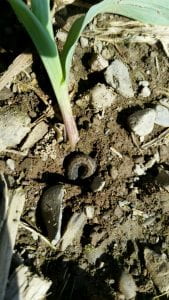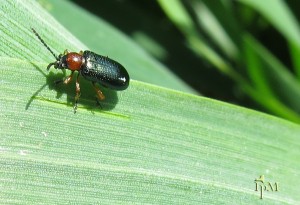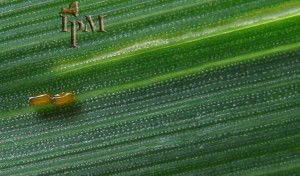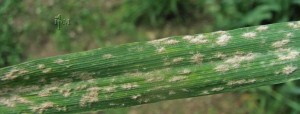Volume 18 Number 6
Contents
View from the Field
Black Cutworm larvae are starting to show up in cornfields. If you find plants cut off at the base it is likely black cutworm larvae. Since this pest only feeds at night, you most likely will not see it. They will hide in the soil near or next to a plant.
Cereal leaf beetle is was found in small grains near Aurora this week. Cereal Leaf Beetle in Small Grains
Cereal Leaf beetle is considered a minor pest of wheat and other small grains. HOWEVER, it has increased in some areas of the state.
The adults are 3/16 inch long with metallic bluish-black head and wing covers.
Eggs are found on the upper surface of the leaves near the midrib. Eggs are elongate, yellow to brown about 1/16 inch long, and are laid in chains of two or three.
Small black slug-like larvae emerge from the egg and reach about a 1/4 inch long. Larvae feed on the leaf surface, leaving long narrow white strips between the veins.
Cereal leaf beetle damage
Cereal leaf beetle is normally more of a problem in oats but can occasionally reach threshold levels in wheat. There is no threshold for cereal leaf in small grains for forage. The threshold for small grains harvested for grain is before the boot stage there must be 3 or more larvae plus eggs per stem. But after the boot stage the threshold is one or more larvae per flag leaf.
There are reports of finding substantial amounts of powdery mildew in small grains. See article below on powdery mildew in small grains.
I was finding 1st and 2nd instar alfalfa weevil larvae. Many fields were harvested the last few days. This year has been so cool weevils are behind alfalfa development. In years like this weevil can hold over and feed on the regrowth.
We have been monitoring true armyworm with pheromone traps across the state and have had very low numbers caught. This does not mean you will not get them. We have had few reports of damage to emerging corn by true armyworm. Keep a lookout for this kind of damage to corn. It might be true armyworm.
Armyworm and damage to young plants
Weather Outlook –June 6, 2019
Samantha Borisoff
NOAA Northeast Regional Climate Center, Cornell University
After today, a long awaited dry period is in store through at least late Monday. Temperatures across the region will be near or slightly above normal for the entire week. Highs will be in the mid 70s to mid 80s and lows will be in the low to mid 50s. The next storm system will affect the region on late Monday and Tuesday. Tuesday looks like the wettest day of the week, with many places seeing 1-2 inches of rain. Overnight temperatures Monday and Tuesday will be on the warm side (up 50- up 60) with cloudy overnight conditions. With the sunny/warm conditions over the next 3-4 days, evapotranspiration should be very high since we are nearing the summer solstice. Expect near 0.25 each day. The 8-14 day forecast calls for yet another trough to establish over the Northeast. This should yet again delay the start of summer with cool/wet conditions forecast over the state.
National Weather Service watch/warnings map
Powdery mildew in your wheat or barley? What are your management options?
By Jaime Cummings, NYS IPM, and Mike Hunter, CCE NCRAT
Powdery mildew infection in winter malting barley (photo by J. Cummings)
One of the easiest foliar diseases to identify in your small grains fields is powdery mildew. Most of us are familiar with this unsightly disease that we usually see low in the canopy during prolonged periods of wetness. Depending on the cultivar and the weather, powdery mildew is often just a cosmetic annoyance that clears up as soon as things heat up and dry out, having very little effect on final yield or grain quality. But sometimes, it can be problematic and you may need to consider your options for managing this disease.
Though all of our grass crops are susceptible to powdery mildew, each crop species has its own fungal pathogen species of powdery mildew. The powdery mildew causing fungi are obligate pathogens, meaning that they require a living host plant for growth, and they can infect any above-ground plant tissue of a susceptible host. The pathogens produce survival structures, called cleistothecia, which overwinter on straw or stubble left in the field. Spores produced in the spring infect our wheat or barley any time after emergence and the lesions initially look like small yellow spots. The fungal growth is mostly superficial, and becomes obvious as the fluffy white mycelium that many of us are familiar with (Fig. 1). If conditions are cool and wet, the disease cycle may continue as more spores are released into a favorable environment. The disease usually initiates on lower leaves, but it can progress all the way up to the flag leaf on susceptible cultivars under optimal conditions.
Figure 1. Fluffy white mycelium of the powdery mildew fungal pathogen with the dark cleistothecia on a wheat stem. (photo by T. McClelland)
Last week, reports came in from Mike Hunter (CCE NCRAT) and Terry McClelland (McClelland’s Agronomic Consulting) of some intense powdery mildew in winter wheat in Jefferson County. This wet spring has provided perfect conditions for a powdery mildew epidemic in many parts of the state. Given the intensity and prolonged duration of the epidemic, they wondered about potential management options. Considering that the wheat was approximately a week away from flowering and fungicide application for Fusarium head blight, they wondered if they should apply a fungicide now or just wait for the flowering application, or both. To make the best decision, we had to consider a few things to determine what might be most cost-effective, and what products would work best or are labeled for sequential applications.
When it comes to yield, it’s primarily the top two leaves that contribute the most in wheat. Therefore, it’s important that we keep those top two leaves green in order to protect yield. As I mentioned, under favorable conditions with a susceptible cultivar, powdery mildew could potentially progress all the way up through the canopy and significantly reduce yields and grain quality. If you have a good stand with high yield potential in this sort of situation, it may be warranted to consider a flag leaf application of a foliar fungicide to keep the disease from progressing and causing serious damage to your crop.
Powdery mildew on wheat leaf. (photo by K. Wise)
A number of foliar fungicides are labeled for powdery mildew on small grains in NY, including many strobilurin, triazole and mixed modes of action products (see the Cornell Guide for Integrated Field Crop Management table 5.7.1 for a complete list). The triazole products tend to have better efficacy against powdery mildew than the strobilurins, but both work well. Most wheat and malting barley growers probably already have the triazole fungicide products Prosaro or Caramaba on-hand for protection against Fusarium head blight, and both of these products work well against powdery mildew. Typically, when we aren’t at epidemic levels of powdery mildew or other foliar diseases, we can rely on a single application of one of these products at flowering (Feeke’s growth stage 10.5.1) to protect against Fusarium head blight and ensuing mycotoxins and to protect those top two leaves from any leaf blights.
But this year, some wheat growers are facing serious powdery mildew pressure in their fields, and they may not want to risk waiting until that flowering application to get those leaves protected. In that case, it’s justified to consider a flag leaf application of a strobilurin or triazole fungicide, followed by a flowering application of a triazole. Please keep in mind that it is not recommended to apply a strobiluring fungicide against Fusarium head blight, as these products may increase mycotoxin levels in the resulting grain.
The question then arises, which products can you use in sequential applications? It’s important to note that while Caramba’s label allows for sequential applications with a maximum product rate of 34 fl ozs/A per season, Prosaro is restricted to a total maximum product rate of 8.2 fl ozs/A per season. Prosaro is typically applied to wheat at 6.5 fl oz at flowering, so you wouldn’t be able to apply it again at flowering if you choose to use it for a flag leaf application for powdery mildew. The top rated foliar fungicides against powdery mildew in NY include Caramba, Tilt, Aproach Prima, Avaris, Quilt Xcel and Aframe Plus. Always read and follow all label restrictions when selecting and applying pesticides.
Luckily, not every year is as conducive for powdery mildew as this one, and it’s usually not necessary or recommended to spray for this typically cosmetic disease. Do what you can to prevent epidemics of powdery mildew and other foliar diseases of small grains through an integrated management approach by selecting and planting at least moderately resistant cultivars, having balanced fertility, and utilizing good field sanitation through crop rotation and possibly burying residues via tillage.
Photo by Jenn Thomas-Murphy, Cornell University.
Fusarium head blight commentary, June 4, 2019:
Dr. Gary Bergstrom, Extension Plant Pathologist, Cornell University
The Fusarium Risk Assessment Map (http://www.wheatscab.psu.edu/riskTool.html) continues to indicate a moderate to high risk of Fusarium head blight (FHB) for several areas of New York. Much of the state’s winter wheat will initiate flowering this week. The triazole products Caramba and Prosaro are the most effective fungicides for suppression of FHB and deoxynivalenol (DON) mycotoxin contamination when applied at flowering (emergence of yellow anthers on heads). A flowering application of triazole fungicide should be based on Fusarium head blight (FHB) risk as well as the risks of powdery mildew, rusts, and fungal leaf blotches in the upper canopy based on scouting of individual fields. There is an application window of approximately 7 days from the beginning of flowering in which reasonable FHB and DON suppression can be expected.
All but the latest planted winter barley is beyond the timing for a fungicide application. In barley, maximal suppression of FHB and grain contamination by deoxynivalenol (DON) mycotoxin results when fully emerged heads are sprayed with full label rates of Caramba or Prosaro fungicides. Application up to 7 days after full head emergence may still result in significant suppression of FHB and DON.
Black Cutworm Captures
True Armyworm Moth Captures
New York Field Crop Pest Degree-Day Accumulations for selected locations
(June 9, 2019)
Clipboard Checklist
Keith Waldron, NYS IPM
General
*Walk fields to check general field condition, weed issues, areas of soil erosion
*Watch for early season weeds: winter annuals, chickweed, henbit, field penny cress, shepherd’s purse, giant and common ragweed, purple deadnettle, lambsquarters, redroot pigweed, velvet leaf, Pennsylvania smartweed, common sunflower, quackgrass, foxtail
Alfalfa:
*Evaluate established legume stands for approximate days til harvest
*Monitor regrowth for alfalfa weevil, potato leafhopper
*Monitor new seedings for Pythium blight and Phytopthora Root Rot.
Small Grains:
*Monitor winter grain fields for growth stage, disease issues, cereal leaf beetle
*Check stands for diseases, cereal leaf beetle, weed escapes
*Monitor wheat for potential risk of fungal disease issues – consult Fusarium Head Blight
prediction model
Corn:
*Conduct plant population assessments, early season corn pests including seed corn maggot, white grub, wireworm, black cutworm, armyworm, slugs, diseases, weed issues, vertebrate damage
Soybeans:
*Post emergence weed evaluation, timely cultivation and/or weed management
*Conduct plant population assessments, early season corn pests including seed corn maggot, slugs, soybean aphid, diseases, weed issues, vertebrate damage
Pastures:
*Check and mend fences as needed.
*Check crop growth
*Invasive species, plants harmful to livestock
*Review/Plan rotation system
Equipment:
*Remove / clean soil and crop debris from equipment
*Arrange for custom weed control or check your own application or cultivator equipment for repairs.
*Carry appropriate / necessary NYS DEC and EPA required documents: (pesticide applicators license, pesticide labels, MSDS sheets, etc.) with application equipment
*Calibrate:
- planting equipment – maintain records on planting rate per field
- manure spreaders – maintain records on amount spread per field
- pesticide application equipment – Check nozzles, pumps, etc., recalibrate pesticide application equipment before use. Maintain pesticide use records
Storage:
* Check stored grain bins for temperature, moisture and signs of mold and insects. Aerate, core, transfer grain or treat as necessary
*Check forage allocation and anticipate feed program adjustments as forages from previous year are used up
*Plan where forages should be stored for optimum allocation next feeding season
*Mow around storage bins and facility to minimize pest hiding places
Dairy Cattle Barn Fly Management:
*Monitor animals and barn area for house fly, stable fly and other pest management needs including presence of rodents and birds.
*Check facilities for favorable fly breeding conditions: (organic matter + moisture): leaks in watering systems, roof gutters for leaks and potential overspill, drainage,
*Sanitation, sanitation, sanitation – clean animal resting areas, feed troughs, minimize source of moist organic matter i.e. fly breeding areas in barn and in adjacent animal loafing yard
* Continue fly monitoring: install “3X5″ index card fly speck monitoring cards throughout barn
*Use, replenish, replace fly management materials: sticky fly tapes/ribbons, insecticide baits, natural enemies (parasitoids), fly population monitoring (3 x 5) spot cards
*Consider purchase and release of Muscidifurax raptor and/or M. raptorellus natural enemies of house and stable fly pupae.
Dairy Cattle on Pasture:
*Monitor animals for presence of face flies, horn flies and stable flies. Action guidelines: face flies (average 10 per animal face), horn flies (average 50 / dairy per animal side, 200 / beef cattle per animal side), stable flies average 10 per animal (all four legs)
*Check feed bunk / water source locations for signs of stable fly breeding (moist undisturbed organic matter – spilled feed, round bales, etc.), minimize source of moist organic matter i.e. fly breeding areas in barn and in adjacent animal exercise yard.
*Check pasture for forage quality / quantity, rotate as appropriate
*Check pasture for vegetation poisonous to livestock
*Consider use of pasture fly traps to help reduce deer, horse and stable fly populations
















